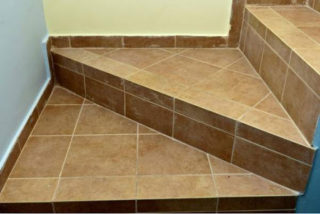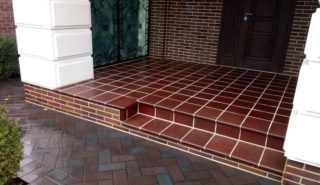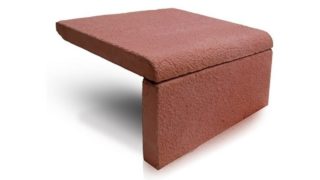Steps wear out more than other building structures. To extend their service life, cladding with durable materials should be carried out. One option is to lay the tiles on a degree.
Traditional arrangement of flights of stairs

Most stairs and flights of stairs are made of concrete. They are:
- prefabricated;
- monolithic;
- typesetting.
Using ceramics and laying tiles on steps is a simple and cheap way to restore the geometric dimensions and aesthetic qualities of worn out and defective steps with minimal additional stress.
Ceramic cladding
Modern technologies for the manufacture of artificial cladding products based on clay allow you to:
- imitation of any finishing or artificial stone;
- suture or seamless laying technology;
- simple finishing methods, the use of additional ceramic elements.
Three main types are commonly used:
- tiled;
- porcelain stoneware;
- clinker.

Clay serves as raw material for all types, but manufacturing technologies differ significantly. Before laying tiles on an internal or external staircase, you need to familiarize yourself with their features.
Manufacturing technology tiles came from ancient times. After molding, plastic clay tiles of the desired shape and size are dried, covered with a thin layer of thermal glaze, and then fired in high-temperature ovens. Modern technologies differ from old methods by mechanization of processes, as well as by computer-aided design of colors, patterns, ornaments applied by means of typographic offset printing.
Porcelain stoneware - a material that is obtained by firing clay raw materials at a higher temperature and pressure than for ordinary tiles. The strength of the finished product is comparable to the characteristics of granite - increased resistance to abrasion, chemical, mechanical stress, for example, point impacts. Its color and pattern are obtained immediately upon firing without the use of glaze. Available in sutured and seamless designs.
Porcelain stoneware tiles are capable of imitating other finishes - valuable types of stone, wood, and other similar coatings. Application - interior and exterior work, including the department of stairs, porches, flat surfaces of entrance groups of various modifications.
Clinker the tiles are made of slate clay by extrusion (squeezing out) of a specially prepared composition - clinker. After firing, a durable fine-porous frost-resistant ceramic is obtained with a set of useful properties that allow it to be used inside and outside buildings. Laying clinker steps allows you to imitate brick, wood, natural finishing stone of various species.
Choice of cladding

Ordinary glazed tiles are laid on the steps of private houses. In buildings of cultural and domestic or commercial and entertainment purposes, its use is impractical. Intensive use quickly destroys its glazed coating, making it matte and wrinkled with a network of deep scratches.Due to the porous structure and low bending compressive strength, through cracks can form in this finish, which develop into spalling and delamination.
For reliability and improved performance in cladding, porcelain stoneware or clinker is recommended. Porcelain stoneware has the best properties of durability, strength and aesthetics. The relative high cost is sometimes compensated for by cheaper clinker with slightly different properties.
For finishing stairs and staircases, you can select special products with the desired modular size, configuration, applied with safe anti-slip risks. There are samples with a thickening of the lower surface (beak) at the junction of the riser, forming an overhanging overhang of the tread console, giving the finished staircase a familiar look. Cladding kits include corner pieces, overlays, masking joints for edge decoration.
Important points and recommendations

To simplify the work, the laying of steps begins with treads. Their upper edge should overhang the vertical by at least an amount equal to the thickness together with the adhesive composition.
At the final stage, a riser is installed in the space between the upper and lower treads. Depending on the deformations and curvatures that the staircase has, as well as the quality of its initial assembly, it may be necessary to trim and adjust the risers in height.
It is recommended to install treads with a slope of 1-2 ° to prevent water accumulation with the formation of dirty, hard-to-remove deposits when washing floors or rainfall outside buildings.
Placing heavy (more than 5 mm thick) basalt or similar natural finishing stone on the steps will result in additional loads on the staircase walls and their foundations, which may require an increase in the bearing capacity.
Instructions for laying tiles on the steps with your own hands

The stacking technology can be expanded into several operations
- Preparation of the necessary tools and accessories.
- Preparation of tiles and bonding materials. For laying on mortar, it is better to use a dry mixture for lining in paper bags, weighing from 3 kg, containing everything you need.
- Removal of flaking fragments and chips.
- Preparation of the working base. To do this, you need a cement-sand or completely polymer-based concrete mortar. They align the planes, complement the lost details.
- Maintenance of the repaired surface and waiting for half of its design strength
- Layout, trimming and dry fitting. When it is required to match the seams along the entire length of the span, the construction nylon cords are pulled.
- Priming the base and back surface.
- Preparation and preparation of adhesive mixtures - cement-sand or glue-polymer.
- Applying an adhesive to the tile, pressing it tightly against a horizontal (tread) or vertical (riser) surface, final alignment (use a bubble level). Temporary plastic crosspieces are available to calibrate the thickness of the joints.
- Grouting with colored compounds matching in shade or contrasting.
The tiling of the threshold is carried out in almost the same order. First, the upper horizontal tile is laid with double-sided cantilever projections corresponding to its thickness together with the adhesive layer. Then, after fitting and trimming, the side cladding is installed in the resulting space.








